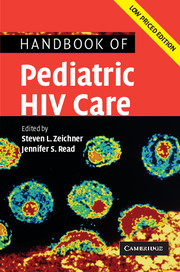Book contents
- Frontmatter
- Contents
- List of contributors
- List of abbreviations
- Foreword
- Preface
- Part I Scientific basis of pediatric HIV care
- Part II General issues in the care of pediatric HIV patients
- Part III Antiretroviral therapy
- Part IV Clinical manifestations of HIV infection in children
- Part V Infectious problems in pediatric HIV disease
- 30 Serious infections caused by typical bacteria
- 31 Tuberculosis
- 32 Disseminated Mycobacterium avium complex infection
- 33 Fungal infections
- 34 Herpesvirus infections
- 35 Pneumocystis jiroveci pneumonia
- Part VI Medical, social, and legal issues
- Appendix 1 Formulary of antiretroviral agents
- Appendix 2 National Institutes of Health sponsored clinical trials for pediatric HIV disease
- Appendix 3 Selected HIV-related internet resources
- Appendix 4 Selected legal resources for HIV-infected children
- Index
- References
35 - Pneumocystis jiroveci pneumonia
Published online by Cambridge University Press: 23 December 2009
- Frontmatter
- Contents
- List of contributors
- List of abbreviations
- Foreword
- Preface
- Part I Scientific basis of pediatric HIV care
- Part II General issues in the care of pediatric HIV patients
- Part III Antiretroviral therapy
- Part IV Clinical manifestations of HIV infection in children
- Part V Infectious problems in pediatric HIV disease
- 30 Serious infections caused by typical bacteria
- 31 Tuberculosis
- 32 Disseminated Mycobacterium avium complex infection
- 33 Fungal infections
- 34 Herpesvirus infections
- 35 Pneumocystis jiroveci pneumonia
- Part VI Medical, social, and legal issues
- Appendix 1 Formulary of antiretroviral agents
- Appendix 2 National Institutes of Health sponsored clinical trials for pediatric HIV disease
- Appendix 3 Selected HIV-related internet resources
- Appendix 4 Selected legal resources for HIV-infected children
- Index
- References
Summary
Introduction
In developed countries, Pneumocystis jiroveci pneumonia (PCP) is the most common AIDS-defining condition and the most life-threatening infection in children infected with HIV. The incidence of PCP in developed countries has decreased dramatically with the introduction of highly active antiretroviral therapy (HAART) and routine use of prophylaxis.
Biology and taxonomy
Pneumocystis has now been identified as a fungus by genetic analysis, enzyme characterization, and the presence of a translation elongation factor 3 gene found exclusively in fungi [1, 2]. It is not, however, susceptibe to polyenes and azole antifungal agents since it lacks ergosterol, a characteristic of fungal cell membranes and the target of these drugs.
Pneumocystis, a unicellular eukaryotic organism, exists in three morphologic forms: sporozoite, trophozoite, and cyst. Trophozoites (2–5 μm) adhere to alveolar epithelium where they multiply and mature into cysts (5–8 μm). These cysts are round or crescent-shaped thick-walled structures that contain up to eight sporozoites (1–2 μm) which, when released, mature to become trophozoites. The cyst and trophozoite forms are found in lung and pleural fluid.
Epidemiology
Serum antibodies to Pneumocystis can be found in greater than 80% of all children by age 2 to 4 years, suggesting that primary asymptomatic infection occurs commonly in immunocompetent hosts [3, 4]. Since the 1980s, patients most at risk for PCP remain those with advanced HIV disease and impaired cell-mediated immunity. HIV-infected infants are at increased risk of developing PCP, but at much higher CD4+ lymphocyte cell counts than older children or adults.
- Type
- Chapter
- Information
- Handbook of Pediatric HIV Care , pp. 740 - 756Publisher: Cambridge University PressPrint publication year: 2006



